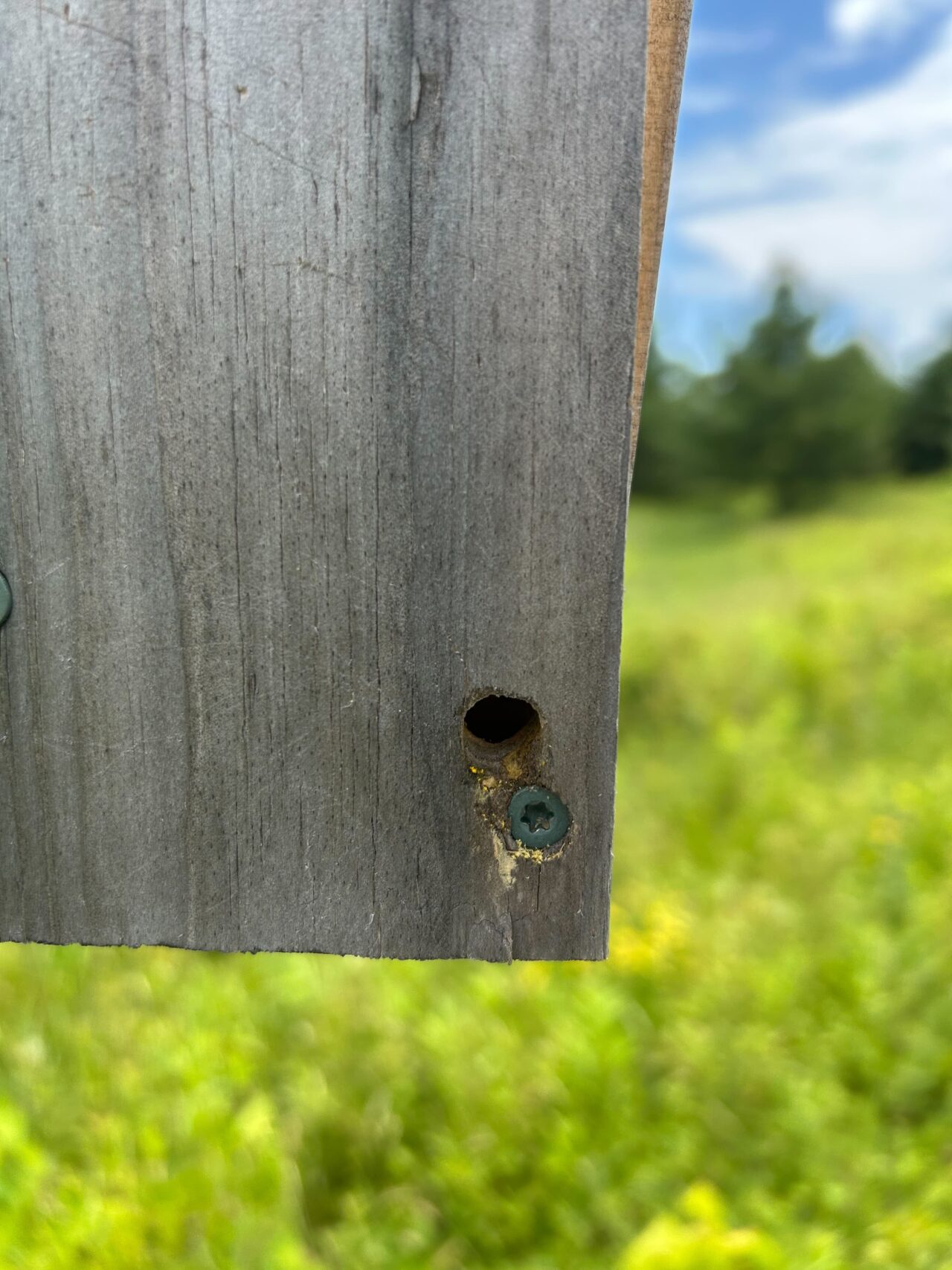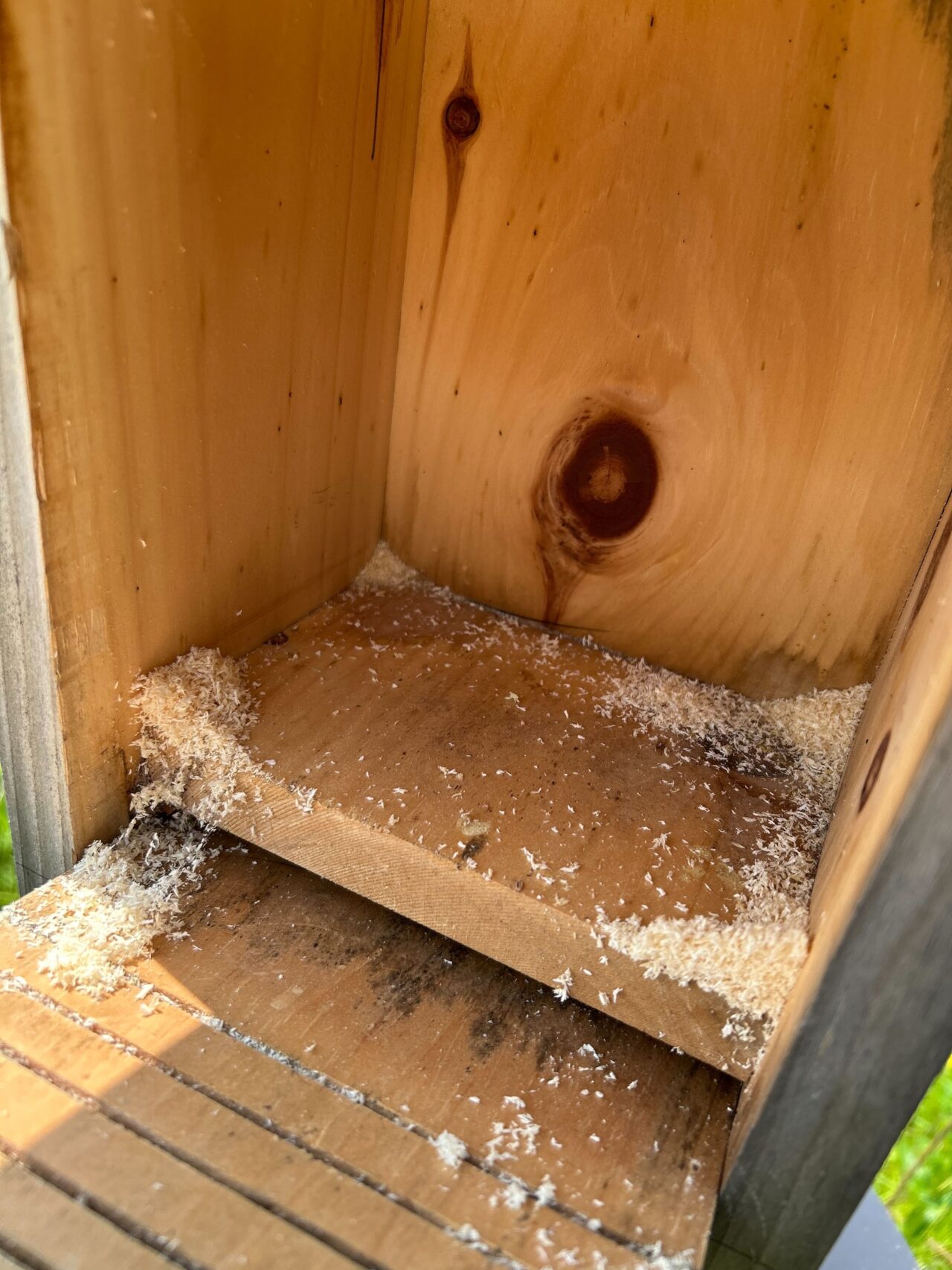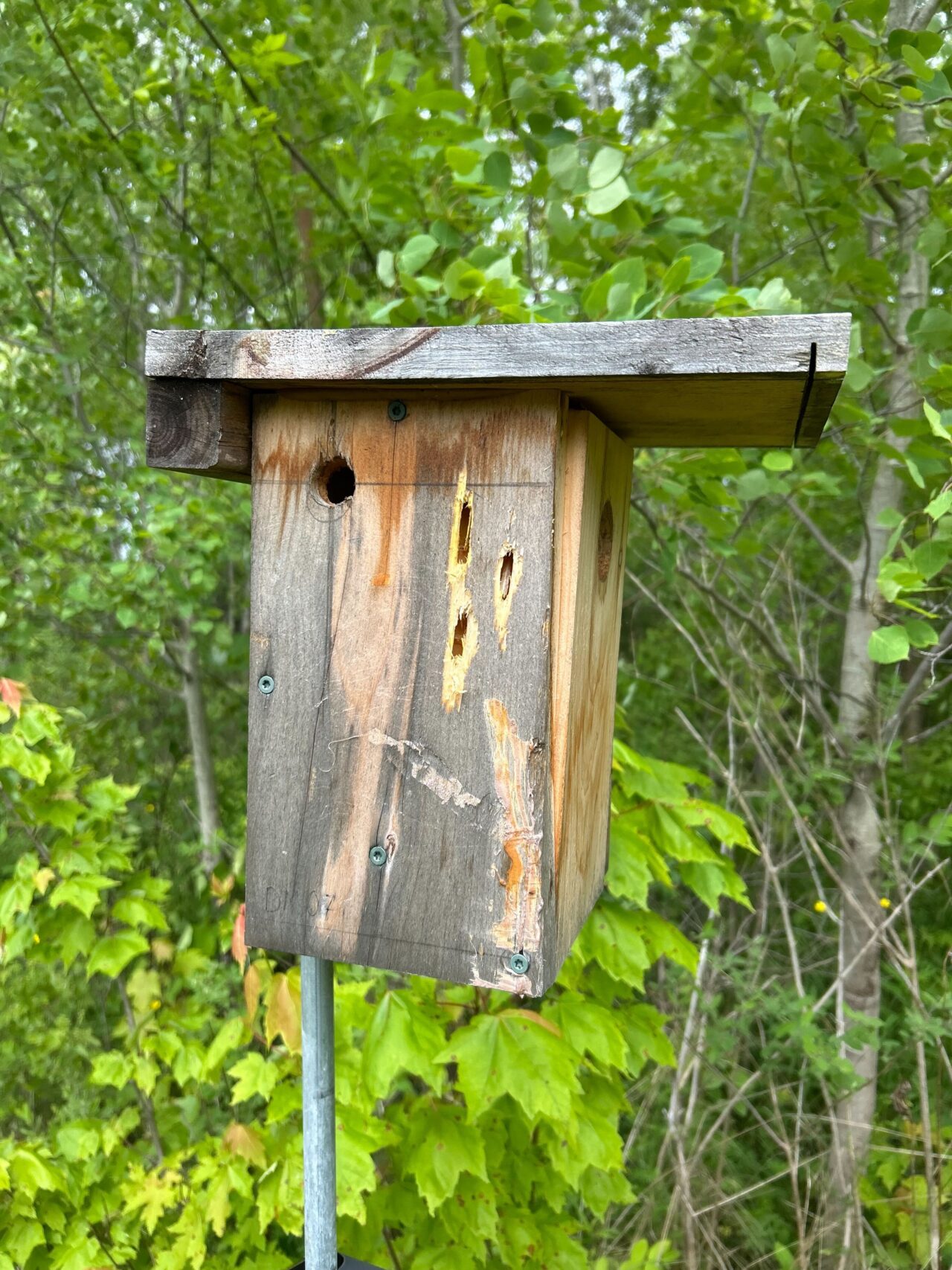Are Carpenter Bees Damaging Your Nest Boxes?
June 26, 2025By Sylvia Park, Cornell Class of 2028
While monitoring nest boxes for my summer learning experience in Sapsucker Woods, I noticed that birds weren’t the only creatures occupying our boxes. Our wooden nest boxes had attracted carpenter bees (Xylocopa spp.), which drill tunnels with almost perfectly circular entrances in soft wood to create their nests. Though these bees aren’t aggressive and are often important pollinators, their presence has caused structural damage, threatening the safety of nest box inhabitants.

That's No Ventilation Hole
The round hole at the bottom right of the box might look like a ventilation hole, but the fresh sawdust gives it away.
Although carpenter bee damage alone usually doesn’t deter birds from nest boxes, the effect is intensified when their predator, woodpeckers, aggressively peck into the bees’ tunnels in search of larvae. This can leave large holes in nest box walls, making it unsafe for avian occupants.
Recognizing Carpenter Bees
Carpenter bees are often mistaken for bumble bees. However they have shiny, mostly hairless black abdomens instead of the fuzzy abdomens of bumble bees.
During nesting season, the female carpenter bees bore a round entrance hole into wood, drill a tunnel, and lay eggs inside. Larvae develop within the tunnel and emerge when fully mature. While females are capable of stinging, they rarely do so; males, despite their territorial hovering near nest entrances, are completely harmless.
It’s important to understand that carpenter bees are beneficial to the environment despite the structural damage they might cause. They are important pollinators for many plant species that provide essential food and habitats for birds and other wildlife.
Signs of Carpenter Bees
- Perfectly round holes—Carpenter bees drill round holes about 0.5 inches in diameter into wooden surfaces. These can appear on the roof, sides, or underside of nest boxes.
- Fresh Sawdust—Fine sawdust piles near the holes signal active excavation.
- Buzzing Sounds—You might hear loud buzzing coming from the holes, especially during warm days in late spring and early summer.
- Visible bees—Female carpenter bees will enter and exit the tunnels, while the males will patrol the area and appear territorial (though are incapable of stinging).
- Damage by Woodpeckers—If you notice irregular holes, long vertical scratches, or shredded wood around the carpenter bee holes, it’s most likely that woodpeckers have found the carpenter bees’ nesting place. This secondary damage weakens the structural integrity of nest boxes and makes it dangerous for birds.

Fresh Sawdust
This sawdust is a clue that carpenter bees were at work.
Prevention and Maintenance
Early detection and repair of carpenter bee damage can help prevent further harm. This can help keep nest boxes in good condition for cavity nesting birds. If you know that carpenter bees are prevalent in your area, consider painting or staining the exterior before installing the box. Carpenter bees prefer bare, untreated wood, and painting the outside of the box can discourage them (see our FAQ on how to paint nest boxes). If you prefer your nest boxes to have a natural finish, apply an annual coating of almond oil to the exterior in the spring.
Check boxes occasionally, especially during the spring for early indicators of boring. If there are signs of damage, reference the guide below on how to repair the box. Ideally, try to start repairs as soon as you notice the first signs of drilling, to minimize the loss of bee eggs or larvae which will eventually be living in the hole. This will also reduce the chance that a woodpecker will enlarge the holes while feeding. If necessary, install metal or plastic plates on the box to prevent carpenter bees from starting tunnels and woodpeckers from further excavating.
Repair Carpenter Bee Damage to Nest Boxes

Woodpecker Damage
Woodpeckers can enlarge holes made by bees while trying to prey on the larvae.
If there are round holes in your nest box, it’s important to take action before the damage compounds or attracts predators like woodpeckers.
- Make sure that there aren’t any adult bees inside it before sealing the hole.
- Take a piece of steel wool, tin foil, wooden plug, or anything large enough to fill the hole and insert it snugly into the entrance. If the tunnel isn’t physically blocked, carpenter bees can easily chew through soft fillers.
- Apply wood filler (choose a product that is designed for exterior use) over the plugged hole to blend with the rest of the box. Once everything is dried, sand the box. Then paint the exterior to discourage any further carpenter bee activity.
Carpenter bees are ecologically important pollinators. With careful monitoring and maintenance, we can create a safe environment for birds without causing harm to these bees that support ecosystems. If you’ve experienced carpenter bee or woodpecker damage at your nest boxes, let us know your observations and solutions in the comments.
References
- Gibb, T. 2015. Carpenter bees. In T. Gibb (Ed.), Contemporary Insect Diagnostics: The Art and Science of Practical Entomology, Chapter 5: Pest Insects, pp. 153–245. Academic Press, Oxford, UK. https://doi.org/10.1016/B978-0-12-404623-8.00005-3
- Penn State Extension. 2024. The Eastern Carpenter Bee: Beneficial Pollinator or Unwelcome Houseguest? Updated February 17, 2024. https://extension.psu.edu/the-eastern-carpenter-bee-beneficial-pollinator-or-unwelcome-houseguest

10 comments on “Are Carpenter Bees Damaging Your Nest Boxes?”
Wow! This article is very interesting and well-written. The author Sylvia must have put a great effort into researching about the bees and birds and of course going through each and every nests. Thank you!
Not in my nest boxes. but in an overhang made of 2 X 4s for holding tools.
Piles of sawdust on the floor. They were boring in the back where it was not painted.
Also a couple in the joists of the carport roof.
I use wood putty to fill the holes. Further painting keeps them away.
There are many other pollinators which are less destructive. I plug the holes as soon as noted for these and put up carpenter bee traps to reduce what will become an infestation the following year. These traps allow you to move the bees to areas without human structures.
I smear spruce pitch/resin into new carpenter bees tunnels. They can’t stand the smell or texture (or both?), and leave.
This is so interesting! I never knew that carpenter bees could be such a damage to birds.
I really liked this article! Thank you!
The carpenter bees have bored holes into my house and the woodpeckers were not far behind. I now have huge holes made by the woodpeckers and have to replace every fascia board on my house – I would never imagined that it could have been so bad!
Wow, what an insightful article! This is truly amazing – I finally figured out the reason as to why I’ve recently been seeing fresh sawdust in my nest box. Time to go take care of carpenter bees, thanks Sylvia! You’re an amazing author.
This is really cool! I’ve always wanted to know more about carpenter bees and woodpeckers ever since I experienced them drilling holes in the wood exterior of my house. Now I know some prevention methods for if I come across them again!
Our nest boxes are mounted on wooden poles, and we have had issues with carpenter bees drilling and nesting in the poles, but not the boxes. Generally, the poles retain structural integrity and it hasn’t been problematic, so we leave them alone. We’ve never had more than two holes in any pole, so we haven’t had to take action.